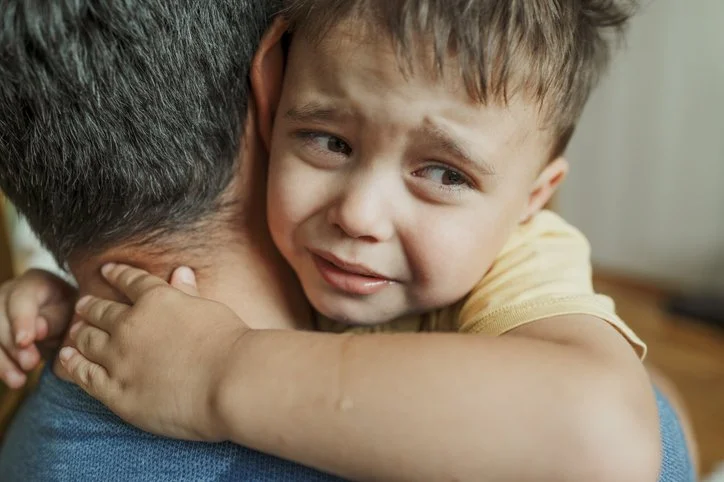How to Raise Emotionally Healthy Sons: A Practical Guide
Part 2 of 2: Creating Safe Spaces and Building Skills
By Joy Stephenson-Laws, Holistic Coach, J.D., Founder
Building on Part 1
In Part 1 of this series, we explored why phrases like "big boys don't cry" damage our sons - examining the brain science behind emotional development and the research showing long-term consequences of emotional suppression. We looked at how men who were taught to hide vulnerable emotions as children often struggle with identifying feelings, expressing distress through anger, maintaining intimate relationships, and seeking help for mental health challenges.
Understanding the problem is essential. But now comes the important part: What do we actually do instead?
The good news: you don't need to be perfect. You just need to be intentional. Here are practical strategies you can start using today.
Haven't Read Part 1 Yet?
If you jumped straight to the solutions, that's okay - this article stands alone with actionable strategies. But I encourage you to go back and read Part 1 when you have time. Understanding why these approaches matter makes them easier to implement consistently, especially when you're tired, stressed, or facing pushback from family members who say "we turned out fine."
Welcome All Feelings (Yes, Even the Hard Ones)
The foundation of emotional health is simple: all feelings are valid information. Not all behaviors are acceptable, but all feelings are.
What this looks like:
When your son is upset, resist the urge to immediately fix it or minimize it. Instead, acknowledge what he's feeling:
"I can see you're really upset. That makes sense. Tell me what happened."
"You seem frustrated right now. Want to talk about it?"
"That sounds really disappointing. I get why you'd feel that way."
Why it matters:
When children learn that their emotions are met with acceptance rather than dismissal, they develop trust - in you, in themselves, and in the validity of their inner experience.
Make Crying Normal
Tears are not a sign of weakness. They're a physiological response that helps the body release stress hormones. When we shame boys for crying, we're essentially shaming them for having a functioning nervous system.
What to say:
"It's okay to cry. Tears help your body let go of big feelings. I'm here with you."
"Crying doesn't make you weak. It makes you human. Even grown men cry sometimes."
"I can see this really hurt. Let it out. I'm not going anywhere."
What NOT to say:
"Big boys don't cry"
"You're fine" (when they're clearly not)
"Don't be a baby"
"Stop crying or I'll give you something to cry about"
Teach Feelings as Skills
Emotional expression isn't just about allowing feelings - it's about teaching appropriate ways to communicate them.
Age-appropriate emotion coaching:
For young children (3-7):
"When you feel angry, you can say 'I feel angry because...' instead of hitting."
"Let's take three deep breaths together when you're feeling overwhelmed."
"Can you show me with your face what feeling you have? Now can you name it?"
For older children (8-12):
"What do you think your body is trying to tell you with that feeling?"
"When you feel that way, what helps you feel better - talking about it, moving your body, or having some quiet time?"
"That's a tough emotion. What do you need from me right now - advice, just listening, or a hug?"
Build Emotional Vocabulary Daily
Most boys (and men) struggle with emotional literacy not because they can't feel, but because they were never taught the words. Make emotions part of everyday conversation.
Simple daily practices:
At dinner: "Share one thing that frustrated you today and one thing that made you happy."
At bedtime: "What was the strongest feeling you had today? Can you tell me about it?"
While reading or watching shows together: "How do you think that character is feeling right now? How can you tell?"
When you model your own emotions: "I'm feeling really stressed about work today. I think I need to go for a walk to clear my head."
Praise Help-Seeking
One of the most dangerous messages boys receive is that asking for help is weakness. We need to actively counter this.
What to say:
"I'm so glad you told me about this. That was brave. We'll figure it out together."
"Coming to ask for help when you're stuck - that's what smart people do."
"Thank you for trusting me with this. It takes courage to be honest about struggling."
Create a culture of seeking support:
Model asking for help yourself: "I'm not sure how to do this. I'm going to ask for help."
Celebrate when your son asks teachers, coaches, or other trusted adults for support
Make it clear that needing help is normal, not shameful
Replace Harmful Phrases
Language matters. Here are better alternatives to common phrases that shut down emotional expression:
Instead of "Big boys don't cry" → Say: "It's okay to cry. I'm here."
Instead of "Man up" → Say: "This is tough. What do you need right now?"
Instead of "Don't be a baby" → Say: "You're having big feelings. Let's talk about it."
Instead of "You're fine" (when they're clearly not) → Say: "You seem upset. Want to tell me about it?"
Instead of "Toughen up" → Say: "That hurt. It makes sense to feel upset."
Identify Safe Adults
Part of emotional safety is knowing who you can turn to. Be explicit about this.
What to say:
"If something ever feels wrong or scary - whether it's something that happened at school, with friends, online, or anywhere else - you can always tell me, Mom, Grandma, your teacher, or your coach. We will listen and believe you. Nothing you tell us will get you in trouble for speaking up."
Why specificity matters:
Children need concrete names and faces, not abstract concepts. "Tell a trusted adult" is vague. "You can tell me, Dad, Ms. Johnson, or Coach Mike" is actionable.
Distinguish Between Managing and Suppressing
To be clear: teaching emotional regulation is healthy and necessary. The key is understanding the difference:
Healthy emotional regulation (teach this):
Taking deep breaths when angry
Using words instead of hitting
Taking a break to calm down before discussing a problem
Recognizing when you need help
Unhealthy emotional suppression (avoid this):
Denying that you're upset when you clearly are
Pretending feelings don't exist
Believing certain emotions are "bad" or "wrong"
Hiding pain to appear strong
The difference: regulation acknowledges the emotion and chooses a response. Suppression denies the emotion exists.
Start Small: One Thing You Can Do Tonight
Overwhelmed by all these strategies? Start with just one.
Tonight at dinner, try this: Ask everyone at the table (including yourself) to share one thing that was hard or frustrating today, and one thing that made them happy or proud. Listen without judging. Show that both feelings matter equally.
This simple practice:
Makes it normal to talk about hard feelings
Builds feeling words through daily practice
Shows you're a safe person to talk to about problems
Models emotional honesty for the whole family
What Success Looks Like
You'll know you're making progress when you notice:
Your son voluntarily shares when something is bothering him
He can name specific emotions beyond just "mad," "sad," or "fine"
He asks for help when he needs it
He sees you as safe person to come to with problems
He shows empathy for others' feelings
He can cry without shame
These aren't signs of weakness. They're signs of emotional health.
The Long Game
Raising emotionally healthy boys isn't about perfection. You'll mess up. You'll sometimes say the wrong thing. That's okay. What matters is the overall pattern - that your son grows up knowing his feelings matter, his voice matters, and he doesn't have to carry heavy secrets alone.
We can raise boys who become men who:
Know what they feel and why
Can tell others what they need
Have close, real relationships
Ask for help when they need it
Handle pain without destroying themselves
Show up for the people they love
Lead with both strength and heart
It starts with letting them cry. With teaching them that their inner world matters. With showing them that speaking up about pain isn't shameful - it's the bravest thing they can do.
Because safe kids are strong kids. And strong kids become men who know that real strength includes the courage to feel.
Joy Stephenson-Laws is the author of "Secrets That Sparkle (and Secrets That Sting): A Rhyming Picture Book for Ages 5+." The book helps children tell the difference between fun secrets and harmful ones, giving them the power to speak up when something doesn't feel right.
Helpful Books for Parents:
Raising Cain: Protecting the Emotional Life of Boys by Dan Kindlon and Michael Thompson
The Wonder of Boys by Michael Gurian
How to Talk So Kids Will Listen & Listen So Kids Will Talk by Adele Faber and Elaine Mazlish
Daring Greatly by Brené Brown
Helpful Websites:
National Alliance on Mental Illness (NAMI): www.nami.org
The Good Men Project: www.goodmenproject.com
Fatherly (parenting advice): www.fatherly.com








